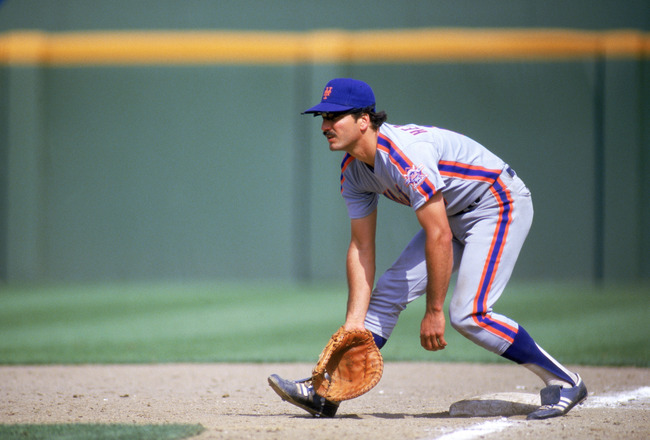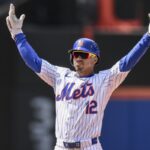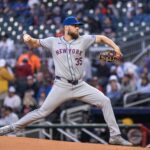
The Mets of the mid and late 1980s was not short on star power. Dwight Gooden, Darryl Strawberry and Gary Carter were vital to their success, but they all revolved around Keith Hernandez: the leader of that group and the primary reason why those teams were perennial winners and champions in 1986.
He’ll receive the highest franchise honor Saturday and on the eve of his No. 17 being retired, here are his top highlights during his distinguished career as a Met (with all due respect to his many moments as a broadcaster and a guest actor):
The Trade
Neil Allen and Rick Ownbey to the St. Louis Cardinals in exchange for Hernandez. From June 15, 1983 to this day, there’s been no better trade in the history of the Mets. It completely altered the culture of a franchise in dire need of leadership, not to mention a winning attitude. With Keith, leadership and success soon followed.
July 24, 1984 vs. Cardinals
Extra motivation, perhaps? Hernandez exacted revenge against his old team — not once, but twice. With the Mets down a run in the eighth, he singled in Jerry Martin to tie at eight. And with the score still knotted in the tenth, his hit off, yes, Neil Allen, brought in Mookie Wilson for the game-winner. Hernandez would be the runner-up in the NL MVP voting as the Mets enjoyed a 32-win improvement from the ’83 season.
July 4, 1985 vs. Braves
Hernandez hit for the cycle and it registered as rather ordinary on the scale of events that took place at Atlanta-Fulton County Stadium — a marathon that saw two rain delays, 29 runs, and ended at 3:55 a.m. He got it with a single in the twelfth, but he should have achieved the feat much earlier after a bad call on what was deemed a catch by Dale Murphy. Nonetheless, Keith achieved the fourth cycle in Mets history and the first in nine years.
September 12, 1985 vs. Cardinals
Call him a Cards killer. Capping off a wild game that saw the Mets build a 6-0 lead then proceed to squander it away completely, Keith went to left field on a Ken Dayley 3-2 pitch to drive in Mookie Wilson from second base as Vince Coleman misplayed the ball in left field. The win put New York in first place over St. Louis, but only temporarily. The Redbirds got red hot over the remainder of the month and beat out the Mets for the division title.
July 4 and 5, 1986 vs. Astros
Dwight Gooden needed some defensive help to protect a 2-1 ninth-inning after allowing a walk and getting two outs. Craig Reynolds’s sharp grounder would have eluded pretty much any first baseman. But Hernandez was no ordinary first baseman. He dove to his right and stepped on the bag to end it.
Hernandez’s incredible range was on display the next night. Jose Cruz pulled a ball that bounded along the first-base line. Somehow, playing on the outfield grass, Hernandez snagged it as he rolled over, got up and tossed it to Bob Ojeda covering first.
July 22, 1986 vs. Reds
This is the essential Keith Hernandez play. Knowing the batter (a pitcher with very little experience), charging a bunt unlike any other at the position, and having the foresight to go for the high reward. It came after the noted brawl ignited by Ray Knight and Eric Davis, thus leaving the Mets without enough position players and forcing Gary Carter to play third base.
Game 6 1986 NLCS: The Hit
Even intelligent hitters like Hernandez seek out others for insight. Bob Knepper was cruising with a 3–0 lead through eight innings and a chance to force a Game 7 versus Mike Scott at the Astrodome. Keith started the day 0-for-3 when he went into the clubhouse to phone his brother Gary, who told him he was too tentative, but the swing was solid. Keith doubled into the right-center field gap to score Wilson and bring the Mets within a run. New York soon tied it, and the game went on…and on…and on…until…
Game 6 1986 NLCS: The Mound Visit
The Mets scored once in the 14th, but so did Houston. The Mets scored three in the 16th, but Houston scored twice. Jesse Orosco was pitching on fumes. His fastball was getting hammered. In came Hernandez, always an on-field pitching coach, to provide instruction. This one was more pointed that most. As the story goes, he told Orosco: “If you throw another fastball, we’re going to have a fight.” Or something to that effect. The motivation worked as Orosco struck out Kevin Bass on three breaking balls and the Mets advanced to the World Series.
Game 7 1986 World Series
Up until his turn at-bat in the sixth inning, with the bases loaded and the Mets looking to cut into Boston’s 3-0 lead, Hernandez was having a poor series by his standards. “I had swung the bat great all series,” Hernandez said in the postgame celebration. “I told [my brother] this morning ‘If I get up with men on base tonight, I’m going to be the man.’” Just like he did in a similar situation in the 1982 World Series, he delivered a two-RBI single that jump-started New York on its way to victory.
First Mets Captain
Hernandez was already the unofficial leader over his three-plus years in New York, but the team made it official. Just prior to the 1987 season, he was named the first captain in franchise history — even sporting the ‘C’ on the left-shoulder of his uniform. He held that role on his own before Gary Carter became co-captain in 1988.
August 3, 1987 vs. Phillies
Keith’s sweet swing had some upper cut to it as he lifted a pitch from Kent Tekulve‘s submarine delivery. The ball had enough carry to sail into the Mets’ bullpen in right field, putting an exclamation point on a 3-2 win in 11 innings. It masked the disappointing news of losing Sid Fernandez to injury, yet another in a laundry list of pitchers who went down that season. It was ultimately the Mets’ undoing in year when they were unable to catch the Cardinals.
Mr. 2,000
The picturesque way for Hernandez to notch a milestone hit? An infield single, of course. Keith was always known for his speed, after all. As part of a three-hit evening and a 12-4 rout of the Cubs in September 1988, Hernandez legged out a grounder to shortstop.
“I knew it wouldn’t be a line drive,” he said afterwards. “My 1,000th was a broken-bat blooper.”
August 5, 1988 at Pirates
Now 34, senior citizen territory for a big leaguer, age made him more susceptible to injury, Hernandez was no longer immune from the disabled list. He missed more than two months with a hamstring pull. When he returned at Three Rivers Stadium, it was like he’d never left. Keith hit a key two-run homer in the seventh in a 3-2 win over New York’s closest competition in the NL East race. With Hernandez missing from the lineup, the Mets were 35-32. While active, the Mets were 65-30.
1988 NLCS
In what was ultimately a disappointing result against the underdog Los Angeles Dodgers, Hernandez (playing his final postseason series) was the second-leading RBI producer with five. Included was a two-run Game 2 homer which brought New York to within striking distance of a comeback. The most memorable moment in this series was a slip-and-slide adventure in the miserable playing conditions of Game 3 at Shea as he was tagged out trying to slither his way to third base.
Eleven in a Row
There is no better defensive first baseman than Hernandez. Not just because he was reliable with the glove, but because of how he expanded the capabilities of the position with range and intelligence. Keith claimed his first Gold Glove as a Cardinal in 1978 and never gave it up for over a decade. He still has the most of any first baseman.
Farewell, for Now
On September 29, 1989, it was a Shea finale for both Hernandez and Carter, both of whom were likely not have their contracts renewed after the season. Keith didn’t start that night against the Phillies, but did make a pinch-hitting appearance to a standing ovation. It turned out to be goodbye as an active player, but we’ve certainly seen and heard plenty more of him since.















